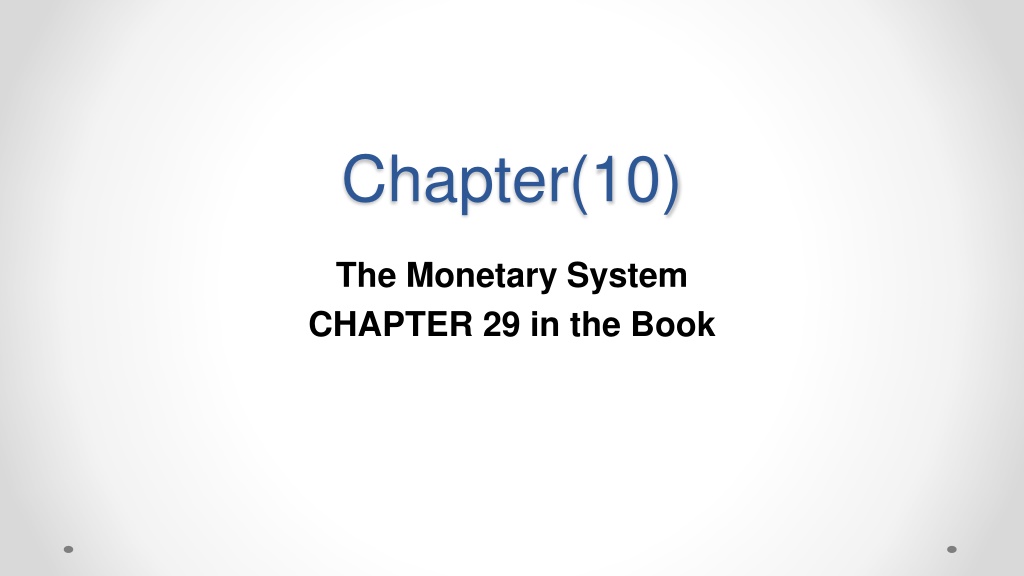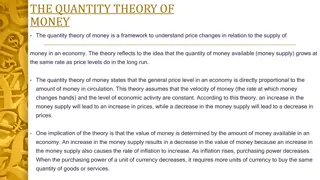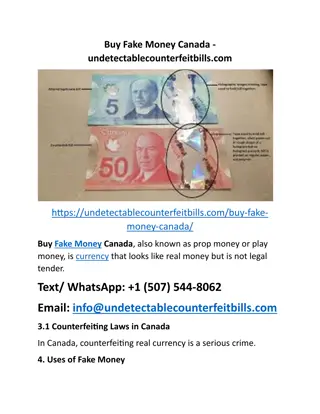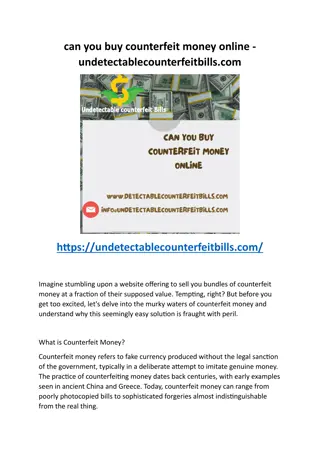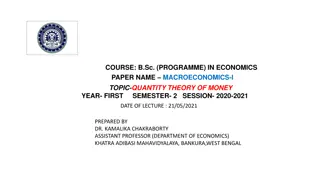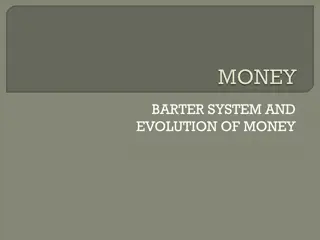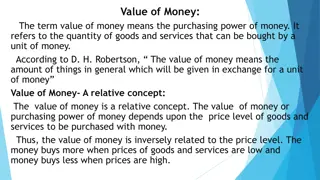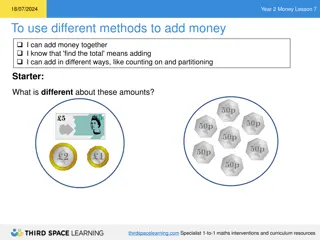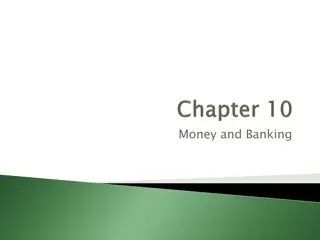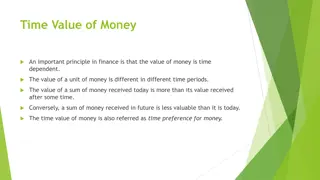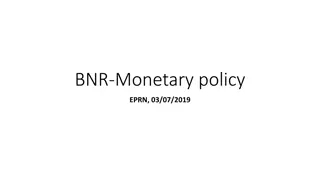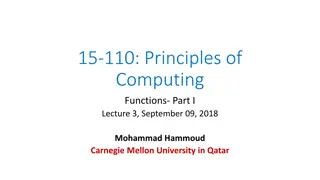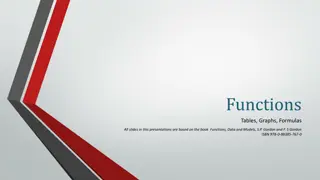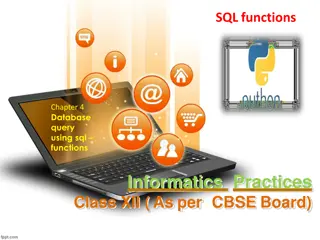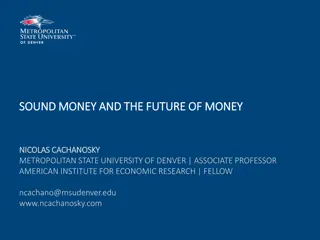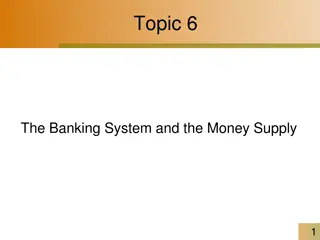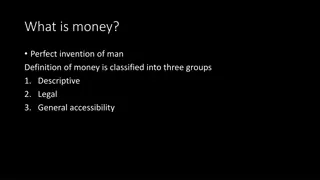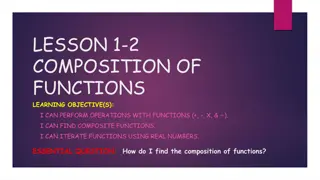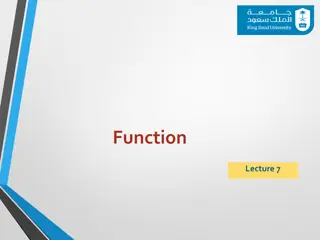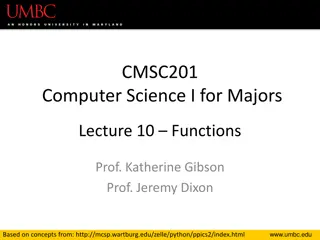Definition of Money and Its Functions
Money plays a crucial role in the economy as a medium of exchange, unit of account, and store of value. Understanding the different types of money from commodity money to fiat money helps in grasping how societies have evolved in their monetary systems.
Download Presentation

Please find below an Image/Link to download the presentation.
The content on the website is provided AS IS for your information and personal use only. It may not be sold, licensed, or shared on other websites without obtaining consent from the author.If you encounter any issues during the download, it is possible that the publisher has removed the file from their server.
You are allowed to download the files provided on this website for personal or commercial use, subject to the condition that they are used lawfully. All files are the property of their respective owners.
The content on the website is provided AS IS for your information and personal use only. It may not be sold, licensed, or shared on other websites without obtaining consent from the author.
E N D
Presentation Transcript
Chapter(10) The Monetary System CHAPTER 29 in the Book
Definition of Money (Meaning of money) What is money? Money is a term commonly used to mean wealth. But, to an economist, money is defined as anything that serves as commonly accepted medium of exchange or means of payment, such as currencies, coins, and checking accounts. All these are accepted as payments for buying goods and services. So money includes only those types of wealth that are regularly accepted.
The Functions of Money Money has 3 functions in the Economy: A Medium of Exchange: Money is an item that buyers give to seller when they want to purchase goods and services. Unit of Account: Money or prices represents the yardstick people use to measure and record the economic value of any product; hence we use money as the unit of measurement or unit of account. Store of Value: Money is an item that people can use to transfer purchasing power from the present to the future.
The Functions of Money Money is the most liquid asset among other assets such as stocks, bonds, houses, and land. But this does not mean that has no risk or that its value is constant. However, money, compared to other assets, is relatively the least risky provided the economy is stable.
The Functions of Money Liquidity is the ease with which an asset can be converted into economy s medium of exchange. Although money is the highly liquid asset, but there is a cost of holding money rather than depositing your wealth in any interest- bearing asset. The cost of holding money is the interest that you would have earned if you have deposited your money in any interest-bearing asset.
The Kind of Money In making use of money, societies have passed through numerous stages: Commodity Money: Barter: Paper Money: Bank Money: Before money came into use, people exchanged goods for goods in a process called barter. replaced the Barter exchange system, where a variety of items such as: iron, gold silver and diamonds serves as Money. represents the most convenient medium of exchange. Currency is called Fiat Money. Fiat Money is money without intrinsic value that used as money because of government decree. Finally comes the Bank Money and these are the checking accounts or demand deposits at commercial banks.
The Kind of Money According to the above definitions. Money represents the paper bills and coins into the hand of people+ Demand or Checkable deposits which are bank accounts that depositors can access on demand by writing cheque. All these items are called money because they can directly used to buy goods and services.
What is meant by the quantity of money or Money Supply? The major components of M-SS or the major monetary aggregates are known today as: M1: called Transactions Money M2: called Broad Money/ Asset Money/ Near Money
M1: Transactions Money M1 includes coins, currency in circulation held outside banks along with checking accounts deposited at commercial banks. So transactions money (M1) consists of those items that are actually used for transactions that is to buy and sell goods and services. Coins and currency add up to about of M1. This is the money held in people s pockets and circulates daily in the markets and this money is held outside banks.
M1: Transactions Money Checking accounts is the third component of M1. These are funds deposited in banks or other financial institutions that you can write checks on. These are known as demand deposits or checkable deposits. Being payable on demand, this deposit serves as money in the same sense that is $1000 in cash do. That is like paper money. M1=currency + coins + demand deposits
M2: called Broad Money/ Asset Money/ Near Money M2 = M1 + Saving deposits ( or accounts) + Small Time deposits ( or accounts) Saving Deposits: is a bank deposit or account providing an interest rate to the passbook holder and does not permit check writing.
M2: called Broad Money/ Asset Money/ Near Money Time Deposit: is a bank deposit requiring a specified minimum amount of funds to be deposited for a specific period of time, and subject to restrictions against withdrawal.
M2: called Broad Money/ Asset Money/ Near Money So M2 includes M1 + other financial assets that are very close substitutes to transactions money, however, they are only considered near money aggregates of M- SS because they cannot be used as direct mediums of exchange to complete transactions: however, you can convert them into cash with no loss of value.
M2: called Broad Money/ Asset Money/ Near Money To sum up, M-SS represents the quantity of money available inside the economy
Banks and the SS of Money In an economy, we can identify two types of banking institutions or organizations: o Central Bank o Commercial Bank
Central Bank A Central bank is a government agency or an institution designed to control, regulates and stabilize M-SS inside an economy, as well as oversees and control the banking system.
Commercial Bank A Commercial Bank is a financial intermediary that transfers funds from one group (Lenders) and (Borrowers). lend it to another group In doing this, they create financial instruments such as checking, saving and time accounts or deposits. But the most important instrument is Bank Money or checking accounts that represents the bulk of M-SS of the economy and held at commercial banks
Reserves of Commercial Banks Reserves are assets or funds held by commercial banks in one or two of the following forms: Excess reserves: are those fractions of reserves that are held in the form of cash on hand held at the banks desk to perform the daily bank operation such as withdrawal and loans. Legal reserves: are those fractions of reserves that are deposited by the commercial banks at the Central Bank according to a ratio called LRR (Legal Reserve Ratio).
Reserves of Commercial Banks The main function of Legal Reserves is not to make bank deposits safe and liquid or payable on demand but their main function is to enable the Central Bank to control the amount of Demand deposits of commercial banks that represent a major part of the M- SS of the economy. Legal Reserves are calculated as of a % of total Bank deposits. This % amount represents The LRR.
The Federal Reserve System and its organization
The Federal Reserve System and its organization In every economy, there exists one Central Bank (called the Federal Reserve System in USA often referred to as the FED) run by a Board of Governors. Only in USA, the FED consists of 12 regional Feb Banks located in NY, Chicago, and other major cities. But the major one is that located in Washington.
The Federal Reserve System and its organization The central Bank is the bank of the Government, also, Bank of the Banks. The Central bank is a public government agency designed to control, regulate and stabilize M-SS and oversees the banking system operations inside the economy.
The Federals Independent The Fed behaves as an independent government agency that acts as the guardian of the value of the nation s currency and the best protector against inflation. Moreover, this independency of the Fed ensures that the monetary policy of the economy is not subject to any political objective or pressure. Commercial banks are members of the Fed.
The Federals Independent The Fed is also allowed to print money and to issue government securities (Bonds) to maintain its mission. Sometimes, the Fed earns profit that go to the government treasury.
The Federals Structure 1- Chairman of the Board of Governors. 2- Board of Governors 3- FOMC (Federal Open Market Committee).
1- Chairman of the Board of Governors At the top position of the Fed is the Chairman of the Board of Governors. The chairman chairs the Board of the Fed and directs the Fed staff. He, also, presides over all Board meetings and the FOMC. He acts as the public spokesman for the Fed and testifies regularly about the Fed policy, and exercises enormous power over monetary policy.
1- Chairman of the Board of Governors He is often accurately called the second most powerful man of the economy after the president The Chairman is generally a Banker or an economist who works full time at the job. He is nominated for this position by the president and confirmed by the government.
2- The Board of Governors The core body of the Fed is the Board of Governors It consists of 7 members nominated by the president and confirmed by the government to serve monetary policy. The 7 members are the Chairman + 6 members or Governors Members of the board are generally bankers or economist who works full-time at the job.
2- The Board of Governors The board members meet with the Chairman and operate under the fed s chairman to formulate and carry out the monetary policy. Functions of the Board of Governors: 1. Approves discount rate. 2. Sets reserve requirement 3. Directs regulatory operations.
3- FOMC (Federal Open Market Committee) The key decision making body in the Fed is the FOMC (Federal Open Market Committee). It consists of 12 members who are: Chairman + 6 members of Board + 5 of the presidents of Regional Fed Reserve Banks (US FOMC). All attend meetings but only 5 members vote by regular rotations.
3- FOMC (Federal Open Market Committee) Functions of the FOMC: 1. Directs open Market operations. 2. Advises on Discount Rate. 3. Advises on reserve requirement. This committee controls the single most important tool of monetary policy which is the Open Market operations.
Balance Sheet of the Federal Liabilities are: 1. Banks Capitals: represent original paid-in capital in full cash by each member bank. 2. Federal reserve Notes are (the Fed s principal liability) These are the paper currency we use everyday. 3. Deposits: 1. Government Deposits or Government Treasury 2. Banks Legal Reserves 3. Foreign Central Bank Deposits. 4. Other Liabilities. Assets are: 1. Gold certificates are warehouse receipts from the treasury for official gold. 2. Government securities (Bonds) or what we call Treasury Bills (TBs). 3. Loans and Acceptances: are primarily loans or advances to commercial banks provided to banks at discount rate. 4. Other assets.
The Feds Tools of Monetary Policy The Fed at its disposal THREE tools or policy instruments and these tools are the tools of the monetary policy which is set and carried out by the Fed to maintain its major goal = Stable M-SS in the economy. So all monetary policy instruments acts on M-SS.
The Feds Tools of Monetary Policy Any monetary policy operation that results with increasing M-SS of the economy is called an Expansionary or Easing Monetary policy. Any monetary policy operation that results in decreasing M-SS of the economy is called Tightening or Contractionary Monetary policy
The Feds Tools of Monetary Policy These instruments are: 1. Open Market Operations 2. Discount Rate Policy 3. Reserve Requirements
1- Open Market Operations OMOs are buying and selling Treasury Bills. A government bond is a certificate of indebt ness of the Federal Government. By selling or buying government securities or bonds in the open market, the Fed can lower or raise bank deposits and reserves. These so-called Open Market operations are the Central Bank s most important stabilizing instrument.
1- Open Market Operations Every month, the FOMC meets to decide whether: a. to increase banks deposits into the banking system by: >> buying TBs from the public (called Easing or Expansionary Monetary Policy) b. to decrease banks deposits into the banking system by: >> selling TBs to the public (called Tightening or Contractionary Monetary Policy).
1- Open Market Operations To see how an OM operation changes banks deposits and reserves, let us suppose that the Fed wants to apply an OM operation to face inflation inside the economy. Suppose that the Fed decides to sell $1 billion TBs to the public. The result is this: When the Fed sells TBs to public, people will end up with less money and more government bonds in their hands.
1- Open Market Operations What happens to M-SS when the Fed sells TBs? People withdraw $1 billion from banks to buy TBs, banks reserves decrease by $1 billion, Banks deposits decrease by a multiplied amount of $1 billion within the limits of the M-SS multiplier, hence M-SS decreases by a multiplied amount of the $1 billion. the consolidated balance sheet of the banking system will also indicate a decrease in total Banks Loans and Investments.
1- Open Market Operations What happens to M-SS when the Fed sells TBs?(Continue) This OM operation of selling TBs in the open market is called Monetary tightening or Contractionary Monetary Policy.
2-Discount Rate Policy It involves setting the interest at which member banks can borrow reserves from the Fed. When the Fed makes loans to banks, these loans are call (Borrowed reserves) given to Banks by the Fed at an interest rate called the (discount rate).
2-Discount Rate Policy If borrowed reserves increase in an economy due to a decrease in the discount rate: this implies that the banks are borrowing more and more from the Fed, >> hence increasing their deposits and reserves resulting in increasing M-SS inside the company. >>Hence Loans and investments increase too and consequently GDP (Process of Monetary Easing).
2-Discount Rate Policy Although Banks Reserves and Deposits increase as the Fed decrease the discount rate, but the Fed cannot consider this policy as a precise instrument to increase or decrease M-SS in a specific amount. That is why this policy is not fully used by the Fed as a precise monetary instrument in achieving a stable M-SS in the economy. WHY?
2-Discount Rate Policy Answer: The Fed can induce or discourage bank to borrow by changing the discount rate policy but it cannot set a precise level of borrowed reserves: If the Fed wants to increase M-SS, all it can do is lower discount rate. The Fed will only expect that banks will increase borrowing by decreasing the discount rate, however, it is only a matter of expectation. The same is the case with respect to increasing discount rate in order to discourage borrowing. However, sometimes even though the Fed is increasing discount rate, the banks will continue to borrow from the Fed for different external reasons.
2-Discount Rate Policy Not only that but the Fed has put limits to the use of this policy by banks; a) The Fed does not allow complete and free and easy use of the discount window by banks. b) Borrowing affects the prestige of the bank. c) There are limits on how much the bank is allowed to borrow from the Fed The main aim of using this policy by the Fed is not mainly to control M-SS but to help financial institutions and banks when they are in trouble.
3- Reserve Requirement Involves changing the LRR on Banks deposits by the Board of Governors of the Fed Reserve requirements are regulations on the minimum amount of reserves that bank must hold against their deposits.
3- Reserve Requirement If the Fed wants to make money tight very quickly, it can increase the LRR for banks, thus decreasing the M-SS creation and reducing the ability of banks lending and investing, hence reducing AD, GDP and inflation.
3- Reserve Requirement And, if the Fed want to ease M-SS, it can do the opposite with respect to the LRR. Hence it decreases the LRR. However, the Fed rarely uses this policy because it highly disrupts the banking sector in the economy.
